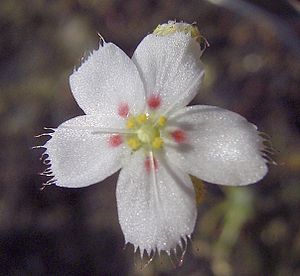Drosera eneabba
| Drosera eneabba | ||||||||||||
|---|---|---|---|---|---|---|---|---|---|---|---|---|

Drosera ennabba , flower |
||||||||||||
| Systematics | ||||||||||||
|
||||||||||||
| Scientific name | ||||||||||||
| Drosera eneabba | ||||||||||||
| N.Marchant & A.Lowrie |
Drosera eneabba is a carnivorous plant from the genus sundew ( Drosera ). It is one of the dwarf sundews and was first described in 1992.
description
Drosera eneabba is a perennial, herbaceous plant with fine, fibrous roots. The plant forms a rosette, remains small and hardly reaches more than 2 cm in diameter. It has a 1 cm large stem on which the withered leaves of the previous season remain, which are often covered with sand, so that only the rosette with young leaves is visible.
The stipules (stipel) that form the survival of the hot summer on Australia's southeast coast, are 4 mm long and 4 mm wide. At the base, the three-lobed stipules are only 1.2 mm wide. The stipple bud is shaggy and egg-shaped, 5 mm high and 3 mm wide at the base.
The leaf blades are elliptical, deeply hollowed out, up to 2.3 mm long and covered with tiny glandular hairs on the underside. Long glands are on the edge of the leaf blade, smaller ones within. The leaf stalks are 4.5 mm long, 0.5 mm wide and covered with a few tiny glandular hairs.
Flowering time is October. The flower stalk (rarely two) is up to 8 cm long and covered with tiny glands. The inflorescence is a coil of 10-15 flowers, covered with short-stalked glands and around 4 millimeter long pedicels . The 2.3 mm long and 1.5 mm wide sepals are covered with some cylindrical, red glands, broadly ovate and notched. The elongated petals are white or light pink with a dark pink colored point near the base, 3 mm long and 1.6 mm wide. The green, slightly reddish ovary is wound, has 0.6 mm diameter and 0.6 mm long. The 5 white styluses are up to 3 mm long. The 5 stamens are 1 mm long. The anthers are white and the pollen is yellow.
The formation of brood scales is typical of dwarf sundews.The elliptical brood scales are formed in large numbers from late November to early December and are 1.1 mm long, 0.8 mm wide and 0.7 mm thick.
Distribution, habitat and status
Drosera eneabba occurs only in the extreme southwest of Australia, near Eneabba and Badgingarra . The endemic plant thrives there mainly on silica and on soils in low heathland.
Drosera eneabba is not uncommon, threatened or introduced in Western Australia.
Systematics
The name " eneabba " is derived from the place where it was found, the Australian city of Eneabba . Drosera eneabba was described as a species by Allen Lowrie and Neville Gaeme Marchant in 1992.
literature
- Allen Lowrie : Carnivorous Plants of Australia. Volume 2. University of Western Australia Press, Nedlands 1989, ISBN 0-85564-300-5 , p. 50.
